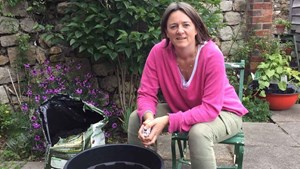Gardening for beginners: top tips from an expert gardening writer
5 minute read

Leading gardening writer Alex Mitchell is the author of five books and a former columnist for The Evening Standard and The Sunday Telegraph. When she is not writing about gardening she runs Mitchell Flower Farm in Kent. In this article she shares her gardening tips – perfect for complete beginners.

Over 50s Home Insurance
Age Co helps you protect the things you love. We’re 100% owned by Age UK and our profits go back to the charity.
I’ve been gardening for many years and love introducing people to the joy of the world of planting, pruning and produce. I’ve grown vegetables, flowers and even started a new garden from scratch. I find it relaxing to potter about in the garden, listen to the birds, and watch my plants grow. I love the creativity and, now that I’m over 50, I find it keeps me flexible and agile.
Gardening can seem a bit overwhelming if you’ve never tried it before. ‘Everything I grow dies,’ beginners tell me. But in truth gardening is really simple. The trick is to start small and choose the easiest plants to grow until you gain confidence. Here is my gardening advice for beginners.
What tools do I need?
All you need are gardening gloves, a hand fork and a watering can. A larger digging fork is useful for flower beds. You can always add more tools along the way.
Start with pots
Pots and windowboxes are a great introduction to gardening for newbies. You don’t even need to dig any soil. All you need is a container, a bag of peat-free multipurpose compost and some plants from the garden centre or online suppliers. A few pots by the back door are easy to look after and create a profusion of colour without much effort.
Try these simple container plant ideas:
- Herbs such as basil, marjoram, thyme, sage and chives for scent and cooking.
- Pansies, petunias, begonias and pelargoniums for colour.
- Trailing plants such as ivy, vinca or creeping jenny.
- Chillis and strawberries to eat.
Top tip: make sure any pot or container you use has holes in the bottom so the water drains.
Flowerbeds for beginners
If you are lucky enough to have flowerbeds in your garden, you can put together beautiful plant combinations and branch out into shrubs and even trees. There may be a little preparation at the beginning but in the long run plants grown in the ground need less attention than those in pots because they can get the moisture and nutrients they need from the soil.

Over 50s Home Insurance
Age Co helps you protect the things you love. We’re 100% owned by Age UK and our profits go back to the charity.
Planning your flowerbeds for planting
All plants grow best when they are not fighting for space with weeds and when their roots can grow easily into the soil. So, before planting, it’s worth doing a bit of preparation. However large or small your garden is, choose a small area to start with. A square metre of ground at a time is a great way to make progress without feeling overwhelmed or straining your muscles.
How to prepare soil for planting
- You will need a hand fork (and possibly a digging fork for stubborn soil).
- Pull or dig up any weeds.
- Dig over the soil with a fork, bashing up large clods and removing large stones.
Now you are ready to get planting.
Easiest flowers to plant
Growing flowers from seed is very satisfying, but it’s easier to buy small plants. Before you choose your plants, think about how much sun your garden gets throughout the day. Then check the plant label to see if it will grow in shade or sun. The plant label will also tell you how large the plant will get so you can give it enough space.
Four easy plants for sunny spots
- Geum ‘Totally Tangerine’ – vibrant orange flowers above a clump of dark green leaves.
- Lavender – great for the bees and smells delightful.
- Geranium ‘Rozanne’ – ideal for filling space in garden borders with lovely purple flowers.
- Erysimum ‘Bowles’s Mauve’ – a small shrub that flowers for months on end.
Four easy plants for shady spots
- Heucheras – pretty frilly leaves and dainty flowers.
- Hellebores – dramatic leaves with large cup-shaped flowers in pink or white.
- Brunnera ‘Jack Frost’ – a great ground cover plant (that spreads to create a carpet and prevents weeds from growing) with pale blue flowers in spring.
- Japanese anemone ‘Honorine Jobert’ – tall, elegant white flowers.
Top tip: thoroughly water any plant straight after putting it in soil. Then you can leave it and not water again until the soil dries out.
Four beginner design tips for planting
You don’t need to be a garden designer to have a beautiful outdoor space. Following a few simple tips can make your planting more pleasing to the eye.
- Buy three or five of every plant. Odd numbers look more natural in the garden.
- Go for wider borders. Wider planting beds mean you can create a lusher look.
- Buy small plants. These are cheaper, easier to establish and will quickly spread.
- Include evergreens. For year-round interest add a few evergreen shrubs or ground cover plants.
Top tip: Visit a Royal Horticultural Society (RHS) garden to see how plants grow naturally in a garden setting and get a feel for colour combinations. Jot down the names of the plants you like from the labels.

Vegetable gardening for beginners
Growing your own vegetables is hugely fun and rewarding. You can pick fruit when it is at its perfect ripeness, and salad leaves when they are crisp and fresh. Here are some easy crops to get started.
Four easy vegetables for beginners
- Tomatoes – the scent and taste of a home-grown tomato is one of the joys of gardening. When growing tomatoes for beginners, Sungold and Gardener’s Delight are reliable, sweetly flavoured varieties. Plant them somewhere sunny and tie the stem to a bamboo cane so they can grow upwards.
- Dwarf french beans – buy plants and give them a sunny spot.
- Courgettes – grow a small plant in a sunny spot with a metre of space. Just one plant will produce enough courgettes for most households.
- Lettuce – sprinkle seeds on the surface of the soil and cover them with a fine dusting of more soil and When they sprout and are about 5cm high, pull out some so you are left with seedlings about 20cm apart.
Top tip: look for varieties with an RHS AGM (Award of Garden Merit) on their label. These are tried and tested to be productive and easy to grow.
Ask your neighbours
An easy way to fill up your garden is to ask your friends and neighbours if they have spare plants. Many plants, such as lady’s mantle, are self-seeders – they produce new plants without human intervention. These can be dug up and shared. Others, such as hardy geraniums and hostas, can be split and a portion planted in a new spot. I find friends are usually more than happy to share their plants and their knowledge. Before too long you may be doing the same too!
Local garden centres and plant nurseries are also great places to ask for advice if you need suggestions for a particular spot in your garden.
Why you should start gardening
Gardening is one of the most rewarding hobbies out there. It’s good for your wellbeing and mental health, good for fitness and, if everything goes to plan, will leave you with something to be proud of.
Here’s a summary of what we’ve covered. My main advice is to avoid overcomplicating things, keep it simple and give it a go.
- Forget fancy equipment – a hand fork, watering can and gloves is all you need to start.
- It’s much easier to nurture small plants rather than grow from seed.
- Planting in pots, rather than a flower bed, will be easier for beginners.
- Plan with your garden in mind. Pick plants that will respond well to the sun or shade.
- Go to local horticultural gardens for inspiration. Ask your neighbours or local garden centres for advice.
Alex Mitchell’s latest book Crops in Tight Spots – Grow Amazing Fruit and Vegetables Wherever You Live is published by Kyle Books.

Sign up to the Age Co Newsletter
Each month, our email newsletter delivers inspiring stories, practical guides to later life, plus the latest news about Age Co and the charitable work we support.
